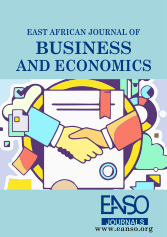Sustainable Human Resource Management and Sustainability: A Survey on Nairobi Securities Exchange Listed Companies, Kenya
Abstract
According to IISD (International Institute for Sustainable Development) “sustainable development is development that meets the needs of the present without compromising the ability of future generations to meet their own needs’’. However, many organizations focus on short-term profits while the contribution of human resource management towards sustainable development is pushed to the margins. Intensive labour practices, poor working conditions and poor work systems in Kenya are some of the issues that have been found not to contribute towards sustainability in organizations and in keeping with the 8th sustainable development goal of Promoting “sustained, inclusive and sustainable economic growth, full and productive employment and decent work for all”. Lack of focus on sustainable human resource management practices will make it difficult for Kenya to achieve Vision 2030 as well as the Sustainable Development Goals (SDG-goals). Sustainable Human Resource management focuses on managing the people resources in an organization so as to achieve long-term sustainable goals that not only benefit the organization but also the society and the environment at large. This Paper is a literature review and analysis on sustainable Human Resource Management and its benefits to the employees, their families and society at large by exploring sustainable HR practices, sustainable work systems and sustainable resource management that also provide for the sustainable performance of organizations in keeping with the need for corporate sustainability. The paper also explores reporting on sustainable HRM practices as part of corporate sustainability reporting in Nairobi Securities Exchange-listed firms
Downloads
References
Chemjor, E. (2020). An Overview of Green Human Resource Management Practices in Kenya. Africa Journal of Technical and Vocational Education and Training, 5(1), 111- 119. Retrieved from https://www.afritvet.org/index.php/Afritvet/article/view/108
Ehnert. I., Parsa. S., Roper. I., Wagner. M., and MullerCamen. M. (2016). Reporting on sustainability and HRM: a comparative study of sustainability reporting practices by the world's largest companies, The International Journal of Human Resource Management. Vol. 27:1, 88-108. Retrieved from https://doi.org/10.1080/09585192.2015.1024157
Ehnert. I, Harry. W. and Zink.K. (2014). Sustainability and Human Resource Management Developing Sustainable Business Organizations. Springer-Verlag Berlin Heidelberg. ISBN 978-3-642-37523-1 ISBN 978-3-642-37524-8 (eBook)
Federation of Kenyan Employers (June 2022). ESG and its Implications for Kenyan Enterprises. FKE Member briefing note.
Guguyu,O. (2022). Only 10 PC of Listed firms Comply with ESG Norms. Business Daily (July 2022). usinessdailyafrica.com/bd/data-hub/only-10pc-of-listed-firms-comply-with-esg-norms-3894194
Indiparambil, J.J. (2019). Strategic to Sustainable Human Resource Management: Shifting Paradigms of Personal Managerial Trends. International Journal of Business and Management Invention (IJBMI). ISSN (Online): 2319 – 8028, ISSN (Print): 2319 – 801X www.ijbmi.org || Volume 8 Issue 03 Series. II || March 2019 || PP 65-70
Jackson, A., Boswell, K., and Davis, D. (n.d.). Sustainability and Triple Bottom Line Reporting – What is it all about? International Journal of Business, Humanities and Technology, Vol. 1 No. 3;(November 2011).
Jeruto. R., Kwasira. J., Chelule. J. and Rop. W. (2017). The influence of green training and development practice on environmental sustainability in selected service-based state corporations in Kenya. Journal of Human Resource and Leadership. ISSN 2519 - 9090X (Online) Vol.2, Issue 6, pp 89 - 100, 2017
Kivuva,E. (2022). Why more than half of Listed Firms are yet to make ESG Disclosures. Business Daily (December, 2022). https://www.businessdailyafrica.com/bd/special-reports/why- more-than-half-of-listed-firms-make-esg-disclosures-4049334
Kramar.R. (2013). Beyond strategic human resource management: is sustainable human resource management the next approach?, The International Journal of Human Resource Management, 25:8, 1069-1089, Retrieved from http://dx.doi.org/10.1080/09585192.2013.816863
Mariappanadar. S. (2003). "Sustainable human resource strategy: The sustainable and unsustainable dilemmas of retrenchment", International Journal of Social Economics, Vol. 30 Issue: 8. Retrieved from http://dx.doi.org/10.1108/03068290310483779
Manini, M.M. (2023). Sustainable Development Goals Disclosures among Top 25 Listed Companies in Kenya. Journal of Economics, Finance and Accounting Studies. SSN: 2709-0809, www.al- kindipublisher.com/index.php/jefas
Owino.W. and Kwasira,J. (2016). Influence of Selected Green Human Resource Management Practices on Environmental Sustainability at Menengai Oil Refinery Limited Nakuru, Kenya. Journal of Human Resource Management. Volume 4, Issue 3, June 2016, Pages: 19-27
Savaneviciene. A and Stankeviciute. Z. (2014). The Disclosure of Sustainability and Human Resource Management Linkage. Human Resources Management & Ergonomics. Vol VIII, issue 1
Tamás,B. (2019). Sustainable human resource management, ISBN 978-3-03921-683-3, MDPI (Multidisciplinary Digital Publishing Institute), Basel. Retrieved from http://dx.doi.org/10.3390/books978-3-03921-683
Wang, C.J. (2019). Linking Sustainable Human Resource Management in Hospitality: An Empirical Investigation of the Integrated Mediated Moderation Model. MDPI Journal on Sustainability 2019. Vol 11(4), 1066; Retrieved from https://doi.org/10.3390/su11041066.
Živile Stankeviˇciute, Z. and Savaneviˇciene,A. (2018). Designing Sustainable HRM: The Core Characteristics of Emerging Field. MDPI Sustainability, 2018. Vol 10. Retrieved from www.mdpi.com/journal/sustainabilit
Copyright (c) 2024 Hellen W. Sang, PhD

This work is licensed under a Creative Commons Attribution 4.0 International License.




























